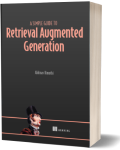A Simple Guide to Retrieval Augmented Generation Edition: 1
Artificial Intelligence
Book Details
Book Title
A Simple Guide to Retrieval Augmented Generation Edition: 1
Author
Abhinav Kimothi
Publisher
Manning Publications
Publication Date
2025
ISBN
9781633435858
Number of Pages
258
Language
English
Format
File Size
6.4MB
Subject
Cybernetics: Artificial Intelligence
Table of Contents
- A Simple Guide to Retrieval Augmented Generation
- brief contents
- contents
- preface
- acknowledgments
- about this book
- about the author
- about the cover illustration
- Part 1 Foundations
- Chapter 1. LLMs and the need for RAG
- 1.1 Curse of the LLMs and the idea of RAG
- 1.2 The novelty of RAG
- 1.3 Popular RAG use cases
- Chapter 2. RAG systems and their design
- 2.1 What does a RAG system look like?
- 2.2 Design of RAG systems
- 2.3 Indexing pipeline
- 2.4 Generation pipeline
- 2.5 Evaluation and monitoring
- 2.6 The RAGOps Stack
- 2.7 Caching, guardrails, security, and other layers
- Part 2 Creating RAG systems
- Chapter 3. Indexing pipeline: Creating a knowledge base for RAG
- 3.1 Data loading
- 3.2 Data splitting (chunking)
- 3.3 Data conversion (embeddings)
- 3.4 Storage (vector databases)
- Chapter 4. Generation pipeline: Generating contextual LLM responses
- 4.1 Generation pipeline overview
- 4.2 Retrieval
- 4.3 Augmentation
- 4.4 Generation
- Chapter 5. RAG evaluation: Accuracy, relevance, and faithfulness
- 5.1 Key aspects of RAG evaluation
- 5.2 Evaluation metrics
- 5.3 Frameworks
- 5.4 Benchmarks
- 5.5 Limitations and best practices
- Part 3 RAG in production
- Chapter 6. Progression of RAG systems: Naïve, advanced, and modular RAG
- 6.1 Limitations of naïve RAG
- 6.2 Advanced RAG techniques
- 6.3 Pre-retrieval techniques
- 6.4 Retrieval strategies
- 6.5 Post-retrieval techniques
- 6.6 Modular RAG
- Chapter 7. Evolving RAGOps stack
- 7.1 The evolving RAGOps stack
- 7.2 Production best practices
- Part 4 Additional considerations
- Chapter 8. Graph, multimodal, agentic, and other RAG variants
- 8.1 What are RAG variants, and why do we need them?
- 8.2 Multimodal RAG
- 8.3 Knowledge graph RAG
- 8.4 Agentic RAG
- 8.5 Other RAG variants
- Chapter 9. RAG development framework and further exploration
- 9.1 RAG development framework
- 9.2 Design stage: Layering the RAGOps stack
- 9.3 Ideas for further exploration
- Index
